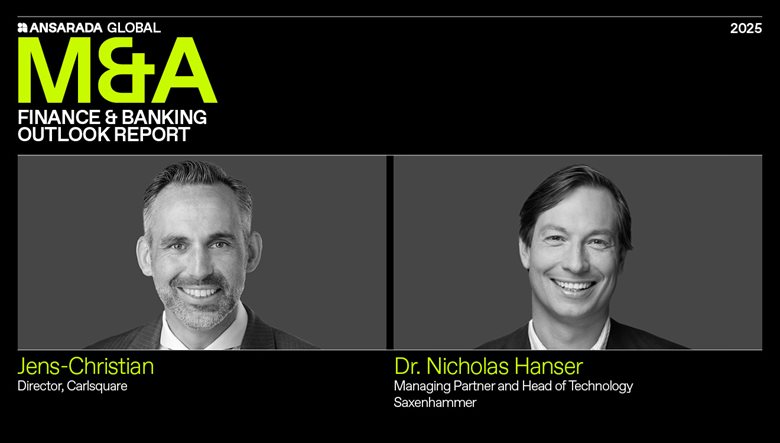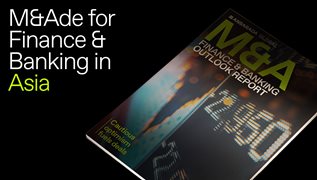Consolidation drives strategic transformation in finance and banking M&A in Europe
Europe's finance and banking M&A market presents a complex picture of both challenges and opportunities in 2025, demonstrating resilience despite experiencing some near-term headwinds.
By AnsaradaTue Jul 08 2025Mergers and acquisitions, Industry news and trends, Innovation

While the region saw a 59% quarterly decline in Ansarada Deal Room activity and a 21% year-on-year decrease in new deals, the underlying fundamentals reveal a more optimistic trajectory. According to our data, Europe achieved remarkable 74% growth when comparing the most recent 12-month period to the previous comparable period, indicating robust underlying demand for strategic transactions.
Dr. Nicholas Hanser, Managing Partner and Head of Technology at Saxenhammer, notes that "The quite heavy global quarter-on-quarter (QoQ) decline of 43% highlights prevailing caution amidst geopolitical uncertainty, inflationary pressures, and tightening monetary policies."
However, he emphasises that "taking into account a very robust 80% increase when comparing the most recent 12-month period to the prior comparable period, these data points suggest a slightly different picture. Financial institutions have evidently recalibrated their strategies, focusing on selective, high-value, strategic acquisitions rather than broad, high-volume activity."
The European banking sector recorded €63.2 billion across 150 deals during the review period, with January 2025 emerging as the strongest month with €12.2 billion transacted across seven deals. This concentrated activity pattern reflects the market's strategic shift toward high-value, transformative transactions rather than volume-driven approaches, positioning European institutions for long-term competitive advantage.
Mega-deal activity reshaping the landscape
Italian banking consolidation
Italy has become the epicenter of European banking transformation, with several landmark transactions driving industry consolidation. UniCredit's €14 billion acquisition of Banco BPM represents one of the largest European financial services transactions in recent years, creating a formidable banking powerhouse positioned to compete with global institutions. Monte dei Paschi's €13.9 billion takeover bid for Mediobanca further demonstrates the aggressive consolidation strategy among Italian institutions, highlighting the sector's push for scale and operational efficiency.
Spanish market developments
The Spanish banking sector continues navigating regulatory changes while pursuing strategic combinations. BBVA-Sabadell merger discussions remain ongoing after the €12 billion deal was sidelined in 2024, with both parties working toward a resolution to satisfy regulators and shareholders. An outcome is expected in 2025. This transaction symbolises the regulatory catalyst theme driving European M&A activity as institutions seek to balance strategic objectives with compliance requirements.
Strategic drivers and market themes
Digital transformation imperative
European financial institutions are increasingly focused on acquiring digital capabilities to remain competitive in an evolving marketplace. Neo-bank competition from players like Revolut and N26 is forcing traditional banks to accelerate digital transformation, creating significant M&A opportunities in the fintech space.
As Nicholas observes, "The rise of Neo-Banks like Revolut and N26 has led to the overall thinking that digital transformation remains a critical growth driver. Financial institutions will increasingly seek partnerships or acquisitions of FinTech firms, especially those enhancing digital customer engagement, artificial intelligence capabilities, cybersecurity and compliance technologies."
Acquisitions targeting firms specialising in digital customer engagement, artificial intelligence capabilities, and cybersecurity are becoming commonplace as institutions recognise the strategic value of technological differentiation.
Cloud banking APIs and compliance technologies represent key acquisition targets, with financial institutions carefully evaluating build-versus-buy decisions based on speed-to-market considerations and internal capability gaps.
Cross-border consolidation
European M&A has spiked 21% since January 2025, with cross-border activity gaining significant momentum as regulatory barriers continue to decrease. Geographic footprint expansion is driving strategic combinations, while regulatory arbitrage opportunities across different jurisdictions offer varying advantages for well-positioned institutions. This scale building reflects the urgent need to compete with US and Asian banking giants that have achieved greater economies of scale through domestic market size advantages.
Dr. Hanser anticipates "increased cross-border M&A activity, particularly involving institutions from regions with relatively healthier economic outlooks. Specifically, the AMER and MEA regions are poised to leverage their relatively stronger economic fundamentals and liquidity positions to seek strategic international opportunities."
ESG and sustainable finance focus
Environmental, social, and governance (ESG) considerations continue to influence deal activity across the European financial services sector. Green asset managers are merging to meet sustainable finance disclosure regulation standards, while climate risk management capabilities are becoming key acquisition criteria for traditional financial institutions.
"While regulatory pressure has certainly eased, environmental, social, and governance considerations are still important, driving institutions toward acquisitions that bolster their ESG credentials and capabilities," notes Nicholas. "We still expect M&A transactions involving institutions that specialise in sustainable finance, climate risk management and ESG data analytics to rise."
Sector-specific analysis
Insurance market dynamics
European insurance M&A totalled €18.9 billion across 401 transactions, with November 2024 representing the strongest month at €5 billion across 42 deals. Specialty insurance consolidation is accelerating as market participants seek scale advantages and risk diversification benefits. Insurtech integration is driving premium valuations as traditional insurers recognise the competitive advantages of technology-enabled customer engagement and underwriting capabilities.
Jens-Christian Fritz, Director at Carlsquare, highlights sector-specific opportunities: "Despite this overall declining trend in M&A deal preparation, we are witnessing high interest in specific sub-verticals within the FinTech space, especially in the German-speaking region. The sub-vertical InsurTech is experiencing significant attention due to the ongoing digital transformation in the insurance industry."
Cross-border expansion into Middle East and Africa markets is providing growth opportunities beyond saturated domestic European markets, with several major European insurers pursuing geographic diversification strategies.
Investment banking, wealth management and securities
European securities firms are following the Asian consolidation model, with boutique investment banks becoming acquisition targets for larger institutions seeking specialized capabilities and client relationships. Wealth management platforms are attracting both strategic and private equity interest as demographic trends drive increased demand for advisory services. Trading technology and algorithmic trading capabilities are commanding premium multiples as market participants seek competitive advantages in increasingly automated markets.
Jens-Christian notes additional wealth management trends: "The private WealthTech sector is seeing increased M&A activity, fuelled by the growing demand for digital wealth management solutions. Notably, a consolidation wave that started in the USA has reached Europe, with active M&A consolidation occurring in the wealth advisory space."
Technology and innovation impact
Artificial intelligence integration
AI is driving both defensive and offensive M&A strategies across the European financial services sector. Cost reduction imperatives are forcing efficiency-focused combinations as institutions seek to maintain profitability amid margin pressure, while customer experience enhancement through AI-powered solutions is becoming a key competitive differentiator. Risk management improvements via predictive analytics acquisitions are helping institutions meet increasingly sophisticated regulatory requirements while improving operational performance.
2025 outlook and predictions
Short-term market dynamics
The first half of 2025 presented mixed signals that influenced near-term transaction activity. Geopolitical tensions are creating short-term volatility that may delay certain transactions, while interest rate normalisation is improving financing conditions for strategic acquirers. Regulatory clarity on digital assets is enhancing deal certainty as institutions gain confidence in long-term regulatory frameworks.
Jens-Christian provides insight into market sentiment: "While the overall M&A sentiment in financial services and FinTech seems to have shifted towards a more reluctant and observing stance, we see some financial services and FinTech verticals with significant interest from both sellers and buyers."
Long-term strategic trends
Several structural factors will drive continued activity throughout 2025 and beyond. Banking union completion is creating larger addressable markets for cross-border transactions, while digital transformation acceleration post-pandemic continues driving technology-focused acquisitions. Climate transition financing is creating new business models that require specialised capabilities and scale advantages.
Nicholas expects "a continued cautious approach where financial institutions pursue fewer but strategically significant acquisitions aimed at enhancing geographical footprint, digital capabilities to catch up with Neo-Banks, operational efficiency or overall market reach. The emphasis will be on transactions that deliver clear synergies or technological advantages as M&A acquirers remain cost conscious."
Expected transaction patterns
European M&A activity in 2025 is likely to feature fewer but larger deals as institutions focus on transformative combinations rather than incremental acquisitions. Technology-heavy transactions will become increasingly common as digital capabilities become essential for competitive positioning. Cross-border activity will continue expanding as regulatory barriers decrease and institutions seek geographic diversification.
Private equity participation in sub-scale financial services businesses is expected to increase as fund managers identify consolidation opportunities and operational improvement potential.
Conclusion
Europe's finance and banking M&A market is undergoing strategic transformation driven by consolidation needs, digital imperatives, and regulatory evolution. While short-term volatility may create temporary challenges, the underlying drivers of scale, technology, and cross-border expansion continue supporting robust deal activity throughout the region.
As Nicholas concludes, "While the immediate Ansarada indicators reflect subdued sentiment, longer-term comparative growth data suggest a more robust underlying appetite for strategically beneficial M&A acquisitions and we remain very positive in that regard. Financial institutions will increasingly adopt a careful, targeted approach in response to macroeconomic challenges, technological disruption, regulatory pressures, and the rising importance of ESG factors."
The market's focus on mega-deals and strategic combinations demonstrates management teams' commitment to building institutions capable of competing globally. With improving economic conditions and continued regulatory support for prudent consolidation, Europe is well-positioned for sustained M&A momentum throughout 2025 and beyond.
Financial institutions that can navigate the complex regulatory landscape while executing technology-driven transformations will be best positioned to capitalize on the significant opportunities ahead, particularly as cross-border barriers continue decreasing and digital transformation requirements accelerate across the sector.


